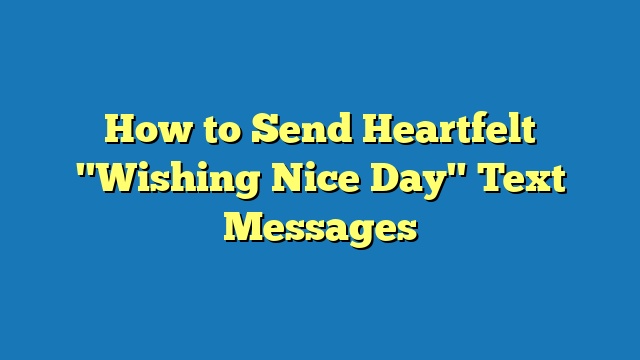Wishing nice day text messages are messages sent to wish someone a pleasant day. They are typically sent in the morning or afternoon, and can include a variety of different messages, such as “Have a great day!” or “I hope you have a wonderful day!”
Wishing nice day text messages can be a simple but meaningful way to show someone you care. They can brighten someone’s day, make them feel appreciated, and even help to improve their mood. One key historical development in the evolution of wishing nice day text messages is the rise of mobile messaging. In the past, people would typically send these messages through email or instant messaging, but now they can be sent quickly and easily through text message.
In this article, we will explore the different types of wishing nice day text messages, the benefits of sending them, and how to write effective wishing nice day text messages.
wishing nice day text messages
Wishing nice day text messages, as a form of communication, possess several key aspects that influence their effectiveness and significance. These aspects collectively contribute to the overall purpose of conveying well wishes and fostering positive interactions.
- Purpose: Expressing goodwill and positive sentiment.
- Content: Typically brief, positive, and uplifting messages.
- Tone: Friendly, cordial, and respectful.
- Timing: Often sent during the morning or afternoon.
- Impact: Can brighten someone’s day and foster a sense of connection.
- Frequency: Varies depending on the relationship and context.
- Personalization: Can include specific details or references to make the message more meaningful.
- Etiquette: Should be appropriate for the recipient and situation.
- Cultural Context: May vary across cultures and languages.
These aspects are interconnected and contribute to the overall effectiveness of wishing nice day text messages. They allow individuals to express their well wishes in a thoughtful and considerate manner, fostering positive relationships and creating a sense of goodwill.
Purpose
Within the realm of “wishing nice day text messages,” the primary objective is to convey goodwill and positive sentiment. This purpose serves as the driving force behind the creation and sending of these messages, shaping their content and overall impact.
- Conveyance of Well Wishes: Wishing nice day text messages are a direct and heartfelt way to express well wishes to someone, conveying a sense of care and concern for their well-being.
- Expression of Gratitude: These messages can also serve as a means of expressing gratitude, acknowledging the recipient’s presence in one’s life and appreciating their value.
- Nurturing Relationships: By sending nice day text messages, individuals can nurture and strengthen relationships, fostering a sense of connection and support.
- Mood Enhancement: The positive and uplifting nature of these messages can have a mood-boosting effect on the recipient, brightening their day and promoting a sense of optimism.
In essence, “wishing nice day text messages” serve as a powerful tool for expressing goodwill and positive sentiment, fostering connections, and creating a positive impact on the recipient’s day. They are a simple yet meaningful way to convey care, gratitude, and well wishes, leaving a lasting impression and contributing to the overall well-being of both the sender and receiver.
Content
The content of “wishing nice day text messages” plays a pivotal role in conveying the intended message of goodwill and positive sentiment. Its brevity, positivity, and uplifting nature are integral components that contribute to the overall effectiveness of these messages.
The brevity of these messages ensures that they are concise and easily digestible, allowing the recipient to quickly grasp the sender’s well wishes without feeling overwhelmed. The positive and uplifting nature of the content serves to brighten the recipient’s day and create a sense of optimism. This positive tone can have a mood-boosting effect, leaving a lasting impression on the recipient.
Real-life examples of “Content: Typically brief, positive, and uplifting messages.” within “wishing nice day text messages” include:
- “Have a fantastic day!”
- “Wishing you a day filled with joy and happiness.”
- “May your day be filled with blessings and laughter.”
These messages are brief, positive, and uplifting, effectively conveying the sender’s well wishes and creating a positive impact on the recipient.
In conclusion, the “Content: Typically brief, positive, and uplifting messages.” aspect of “wishing nice day text messages” is crucial for delivering the intended message of goodwill and positive sentiment. Its brevity, positivity, and uplifting nature work in harmony to create concise, impactful, and mood-boosting messages that can brighten someone’s day and strengthen relationships.
Tone
In the realm of “wishing nice day text messages,” the significance of “Tone: Friendly, cordial, and respectful” cannot be overstated. The tone employed in these messages directly influences their impact and effectiveness in conveying well wishes and fostering positive interactions.
A friendly, cordial, and respectful tone establishes a foundation of warmth, sincerity, and consideration. It creates a sense of genuine care and concern for the recipient, making the well wishes more meaningful and impactful. When individuals receive a message with a friendly and respectful tone, they are more likely to feel valued, appreciated, and connected to the sender.
Real-life examples of “Tone: Friendly, cordial, and respectful” within “wishing nice day text messages” include:
- “Good morning! I hope you have a wonderful day filled with joy and sunshine.”
- “Wishing you a productive and fulfilling day. Remember to take some time for yourself amidst the hustle and bustle.”
- “Have a fantastic day! I’m thinking of you and sending you all my best wishes.”
These messages effectively convey well wishes while maintaining a friendly, cordial, and respectful tone. They create a positive and uplifting atmosphere, making the recipient feel valued and appreciated.
In conclusion, “Tone: Friendly, cordial, and respectful” is an essential component of “wishing nice day text messages.” It establishes a foundation of warmth, sincerity, and consideration, making the well wishes more meaningful and impactful. By embracing a friendly, cordial, and respectful tone, individuals can effectively convey their well wishes, strengthen relationships, and create a positive and uplifting atmosphere.
Timing
The timing of “wishing nice day text messages” plays a significant role in their effectiveness and impact. Sending these messages during the morning or afternoon can optimize their reception and create a positive and uplifting atmosphere for the recipient.
- Morning Motivation: Sending nice day text messages in the morning can provide a positive and encouraging start to the day. These messages can offer a boost of motivation, inspiration, and well wishes, setting a positive tone for the rest of the day.
- Midday Mood-Booster: Sending nice day text messages in the afternoon can serve as a welcome pick-me-up and mood-booster. These messages can help break up the monotony of the afternoon and provide a reminder of positivity and support.
- Afternoon Appreciation: Sending nice day text messages in the afternoon can express appreciation for the recipient’s efforts and accomplishments throughout the day. These messages can acknowledge their hard work, dedication, and contributions.
- Evening Encouragement: Sending nice day text messages in the late afternoon or early evening can provide encouragement and support as the day draws to a close. These messages can offer a sense of camaraderie and remind the recipient that they are valued and supported.
In conclusion, the timing of “wishing nice day text messages” is an important factor that can enhance their impact and effectiveness. Sending these messages during the morning or afternoon allows them to serve as mood-boosters, motivators, expressions of appreciation, and sources of encouragement, creating a positive and supportive atmosphere for the recipient.
Impact
The impact of “wishing nice day text messages” extends beyond simply conveying well wishes; they possess the power to brighten someone’s day and foster a sense of connection. This impact is rooted in the fundamental human need for social interaction and emotional support. When individuals receive a thoughtful and uplifting message, it can trigger positive emotions, boost their mood, and remind them that they are valued and cared for.
Real-life examples abound that demonstrate the transformative impact of “wishing nice day text messages.” Consider the case of Sarah, who was feeling overwhelmed and stressed at work. Upon receiving a simple text message from her friend saying, “Have a fantastic day! Remember to take some deep breaths and know that I’m thinking of you,” Sarah felt an immediate sense of calm and support. The message served as a reminder that she was not alone and that someone cared about her well-being.
The practical applications of understanding the impact of “wishing nice day text messages” are far-reaching. In personal relationships, these messages can strengthen bonds, nurture connections, and create a positive and supportive atmosphere. In professional settings, they can promote camaraderie, boost morale, and foster a sense of community. By embracing the power of “wishing nice day text messages,” individuals can make a meaningful difference in the lives of others and contribute to a more positive and connected world.
Frequency
The frequency of “wishing nice day text messages” is a dynamic aspect that is influenced by the nature of the relationship and the specific context in which the messages are exchanged. This variability is a crucial component of “wishing nice day text messages” as it allows for customization and adaptation to different situations and relationships.
In close relationships, such as between family members or intimate partners, “wishing nice day text messages” may be exchanged more frequently. The high level of intimacy and emotional connection in these relationships often leads to a desire for frequent communication and expressions of care. Daily or even multiple daily messages are common in such contexts, serving to maintain the close bond and provide ongoing support.
In more casual relationships, such as between friends or colleagues, the frequency of “wishing nice day text messages” may be less frequent. The nature of these relationships often involves less frequent interactions, and messages may be exchanged on a weekly or even monthly basis. The purpose of these messages is primarily to maintain a connection and express well wishes, rather than to engage in extensive daily communication.
The context in which “wishing nice day text messages” are exchanged also plays a role in determining their frequency. For example, during special occasions such as birthdays or holidays, the frequency of these messages may increase as individuals seek to convey their well wishes and celebrate the occasion. Similarly, in times of stress or difficulty, the frequency of “wishing nice day text messages” may increase as people offer support and encouragement to those in need.
Understanding the relationship between “Frequency: Varies depending on the relationship and context.” and “wishing nice day text messages” has practical applications in various settings. In personal relationships, it helps individuals navigate the appropriate frequency of messages to maintain healthy and balanced communication. In professional settings, it guides individuals in establishing appropriate boundaries and maintaining a respectful level of communication with colleagues.
In conclusion, the frequency of “wishing nice day text messages” is a dynamic aspect that reflects the nature of the relationship and the specific context in which they are exchanged. Understanding this variability is essential for effective and appropriate communication in both personal and professional settings.
Personalization
In the realm of “wishing nice day text messages,” personalization plays a pivotal role in enhancing the impact and significance of these messages. By incorporating specific details or references, individuals can craft messages that are tailored to the recipient, making them feel valued and deeply cared for.
- Recipient’s Name: Including the recipient’s name in the message adds a personal touch, creating a sense of direct connection and acknowledgment.
- Shared Experiences: Referencing a shared experience or memory in the message evokes a sense of nostalgia and camaraderie, fostering a deeper connection between the sender and recipient.
- Specific Compliments: Offering a specific compliment, such as “I love your sense of humor” or “You’re such a talented artist,” demonstrates that the sender has paid attention to the recipient’s qualities and values them.
- Current Events: Acknowledging a current event or shared interest in the message shows that the sender is engaged with the recipient’s life and cares about their well-being.
Incorporating personalization into “wishing nice day text messages” is an art that requires thoughtfulness and a genuine desire to make the recipient feel special. By taking the time to craft a message that is tailored to their interests, experiences, and qualities, individuals can create a meaningful and lasting connection, leaving a positive and lasting impression.
Etiquette
In the realm of “wishing nice day text messages,” etiquette plays a crucial role in ensuring that these messages are well-received and have the desired impact. Observing proper etiquette involves adhering to social norms and conventions to maintain respect, sensitivity, and appropriateness in communication.
- Tone and Language: The tone and language used in “wishing nice day text messages” should be appropriate for the recipient and the situation. Formal language and a professional tone may be suitable for business associates, while a more casual and friendly tone may be appropriate for close friends or family members.
- Timing and Frequency: The timing and frequency of “wishing nice day text messages” should be considerate of the recipient’s schedule and preferences. Avoid sending messages too early in the morning or late at night, and respect the recipient’s need for space by not sending messages too frequently.
- Content and Relevance: The content of “wishing nice day text messages” should be relevant to the recipient and the occasion. Avoid sending generic messages that lack personalization, and tailor the message to the recipient’s interests or experiences.
- Cultural Sensitivity: Be mindful of cultural differences when sending “wishing nice day text messages.” Greetings and well-wishes may vary across cultures, so it is important to research and respect the recipient’s cultural background to avoid any misunderstandings.
Observing proper etiquette in “wishing nice day text messages” demonstrates respect for the recipient and enhances the overall impact of the message. By adhering to these guidelines, individuals can ensure that their messages are well-received, strengthen relationships, and create a positive and meaningful connection.
Cultural Context
Within the realm of “wishing nice day text messages,” cultural context plays a significant role in shaping the content, tone, and etiquette of these messages. Different cultures have unique customs, traditions, and values that influence how people express well wishes and interact with each other.
- Greetings and Salutations: The way people greet each other and exchange well wishes varies across cultures. In some cultures, it is customary to use formal titles and respectful language, while in others, a more casual and informal approach is preferred.
- Use of Emojis and Symbols: The use of emojis and symbols in “wishing nice day text messages” can also vary depending on cultural context. Certain emojis may have different meanings or connotations in different cultures, and it is important to be aware of these differences to avoid misunderstandings.
- Timing and Frequency: The timing and frequency of “wishing nice day text messages” can also be influenced by cultural norms. In some cultures, it is considered appropriate to send these messages at specific times of the day or on particular occasions, while in others, there is more flexibility.
- Superstitions and Beliefs: Cultural superstitions and beliefs can also impact the content and tone of “wishing nice day text messages.” For example, in some cultures, it is considered bad luck to wish someone good luck directly, and instead, people may use indirect or euphemistic language.
Understanding and respecting cultural differences is essential for effective communication and relationship-building. By being mindful of the cultural context of “wishing nice day text messages,” individuals can ensure that their messages are well-received and have the desired impact, fostering positive connections across cultural boundaries.
FAQs on Wishing Nice Day Text Messages
This section addresses frequently asked questions and provides clear answers to enhance understanding of “wishing nice day text messages.” It clarifies their purpose, appropriate usage, and cultural considerations.
Question 1: What is the purpose of sending “wishing nice day text messages”?
Answer: The primary purpose is to convey well wishes, express gratitude, nurture relationships, and brighten the recipient’s day.
Question 2: What are the key elements of an effective “wishing nice day text message”?
Answer: It should be brief, positive, and uplifting, using a friendly, cordial, and respectful tone.
Question 3: When is the best time to send a “wishing nice day text message”?
Answer: The optimal timing is during the morning or afternoon, offering a boost of motivation or a mid-day pick-me-up.
Question 4: How often should I send “wishing nice day text messages” to someone?
Answer: The frequency varies depending on the relationship and context, but it’s important to be mindful of not overwhelming the recipient.
Question 5: Is it appropriate to personalize “wishing nice day text messages”?
Answer: Yes, personalization can make the message more meaningful and strengthen the connection with the recipient.
Question 6: Are there any cultural considerations to keep in mind when sending “wishing nice day text messages”?
Answer: Yes, cultural differences can influence greetings, language use, and the timing of messages. It’s important to be respectful and sensitive to these variations.
In summary, “wishing nice day text messages” are a thoughtful way to express well wishes and foster positive connections. By understanding their purpose, elements, appropriate usage, and cultural considerations, you can effectively convey your message and brighten someone’s day.
This comprehensive FAQ section provides valuable guidance on the nuances of “wishing nice day text messages.” In the next section, we will explore the benefits of sending these messages and their impact on relationships.
Tips for Sending Meaningful Wishing Nice Day Text Messages
This section provides practical tips to help you craft and send “wishing nice day text messages” that are thoughtful, meaningful, and well-received.
Tip 1: Personalize the Message: Add a personal touch by including the recipient’s name or referencing a shared experience or interest.
Tip 2: Use a Friendly and Uplifting Tone: Convey warmth and positivity through your word choice and sentence structure.
Tip 3: Keep it Brief and Sweet: A concise message is more likely to be read and appreciated.
Tip 4: Be Specific and Sincere: Avoid generic phrases and instead offer specific compliments or well wishes.
Tip 5: Consider the Timing: Sending a message during the morning or afternoon can provide a boost of motivation or a midday pick-me-up.
Tip 6: Respect Cultural Differences: Be mindful of cultural variations in greetings and communication styles.
Tip 7: Avoid Overwhelming the Recipient: While regular messages can strengthen connections, be considerate of the recipient’s preferences and avoid excessive messaging.
Tip 8: Proofread Before Sending: Ensure your message is error-free and conveys your intended sentiment clearly.
By following these tips, you can create and send “wishing nice day text messages” that are both meaningful and well-received, helping to brighten someone’s day and strengthen your relationships.
In the concluding section, we will discuss the impact of “wishing nice day text messages” on relationships and overall well-being.
Conclusion
Throughout this article, we have explored the world of “wishing nice day text messages,” uncovering their significance, impact, and best practices. Key findings include their ability to convey well wishes, foster connections, and brighten someone’s day. The personalization, timing, and cultural considerations involved in these messages play a crucial role in their effectiveness.
This exploration reveals the power of simple yet heartfelt gestures in strengthening relationships and promoting overall well-being. As we navigate the complexities of modern communication, “wishing nice day text messages” stand as a simple yet meaningful way to express care, gratitude, and support.









Tips for Using "Template by Kevin Crafts" Comments for Meaningful Online Discussions